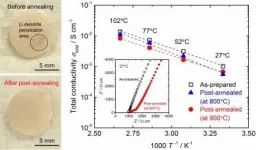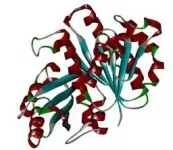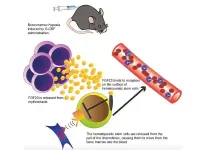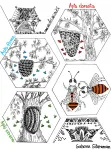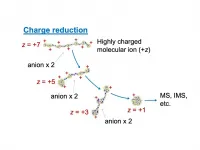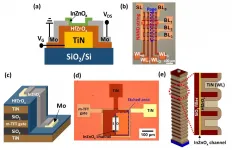What stops flows in glassy materials?
2021-01-19
(Press-News.org) Various glass materials have been essential to the development of modern civilization due to their advantageous properties. Specifically, glasses have a liquid-like disordered structure but solid-like mechanical properties. This leads to one of the central mysteries of glasses: "Why don't glasses flow like liquids?" This question is so important that it was selected by the journal Science in 2005 as one of 125 key, unanswered scientific questions, and one of 11 unsolved important physical issues.
We can hardly observe the movements of atoms at a ~0.1 nanometer length scale and a ~1 nanosecond time scale. Fortunately, however, scientists have found that colloidal systems have similar phase behaviors as atomic systems. Colloids are regarded as big "atoms" that reveal microscopic information about phase transitions that can't be easily obtained from atomic materials.
In the past decade, colloidal glasses have drawn a lot of interest, resulting in numerous important discoveries. However, most of these studies are about spherical particles that tend to form local or intermediate-range crystalline structures. Unfortunately, such studies are not broadly applicable since most glasses are not composed of spheres and have no crystalline structure.
To counter this problem, researchers from the Institute of Mechanics of the Chinese Academy of Sciences and Hong Kong University of Science and Technology recently conducted experimental studies for the first time on glassy systems composed of nonspherical particles.
The researchers found that the monolayers of monodisperse ellipsoids are good glass formers and do not form local crystalline structures. Thus, they provide an ideal and general system for detecting the structural origin of slowing dynamics as the glass transition is approached.
In fact, glass formers have strong dynamic heterogeneities, i.e., some regions move fast and some move slow. These results show that structures with low structural entropy correspond well with slow dynamics, whereas fast relaxing (flowing) regions have high structural entropy.
In glasses composed of spherical particles, some polyhedral structures were usually regarded as responsible for the slow dynamics. However, a type of polyhedron only exists in certain systems of spheres. Structural entropy measures the level of disorder in a structure, including various specific local structures, e.g. virous polyhedra that exist in systems composed of spheres. So, the low structural entropy is a general structural feature of slow dynamics in glassy matter, which holds in systems composed of spheres and non-spheres.
In addition, the researchers observed Ising-like critical behaviors at an ideal glass transition point in both static structures and slow dynamics. Such behaviors are a quantitative feature of thermodynamic transition that explains whether glass transition is purely dynamic or thermodynamic (structural), since there are no ordering structures in glasses.
"The observation of critical behaviors in ellipsoid glasses provides much more solid quantitative evidence of the thermodynamic nature of glass transition," said WANG Yuren, corresponding author of the study. "The results shed new light on both the mysteries of glass theory and designing materials with high stability and glass forming ability."
INFORMATION:
[Attachments] See images for this press release:
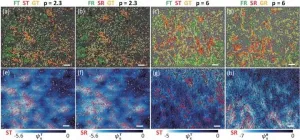
ELSE PRESS RELEASES FROM THIS DATE:
2021-01-19
Overview:
A research team in the Department of Electrical and Electronic Information Engineering at Toyohashi University of Technology and the Department of Chemistry at University of Calgary has investigated the effect of post-annealing for healing Li garnet solid electrolyte degraded by the growth of Li dendrites. The ionic conductivity of the annealed solid electrolyte was slightly lower than that of the electrolyte before annealing but was retained above 10?4 S cm?1 at room temperature. The electrochemical results obtained indicate the possibility of reusing the solid electrolyte degraded by the growth of Li dendrites in another all-solid-state Li battery.
Details:
A ...
2021-01-19
Overview:
The research team of the Department of Computer Science and Engineering at the Toyohashi University of Technology and the Institute of Food Biotechnology and Genomics at the National Academy of Sciences of Ukraine have proposed a new drug to treat tuberculosis (TB), utilizing the state-of-the-art molecular simulations. This drug may inhibit the cell division of Mycobacterium tuberculosis (M. tuberculosis) and suppress its growth. In addition, because this drug acts on the enzymes secreted by M. tuberculosis instead of acting on M. tuberculosis itself, M. tuberculosis ...
2021-01-19
"The real voyage of discovery consists not in seeking new landscapes, but in having new eyes."
Scientists would vouch for this statement because scientific pursuit has the habit of offering chance discoveries if we think about things differently.
In the lab of Arati Ramesh at the NCBS, the team loves to spy on the structure and sequence of Ribonucleic acids (RNAs; molecules that decrypt an organism's genetic code into protein messages). During one such instance, graduate students in Arati's lab were peering at a family of nickel and cobalt (NiCo RNAs) sensing bacterial RNAs that have a clover leaf-like structure. ...
2021-01-19
A Kobe University research group including graduate student ISHII Shinichi and Associate Professor KATAYAMA Yoshio (both of the Department of Hematology, Graduate School of Medicine) have discovered that fibroblast growth factor-23 (FGF23) produced by erythroblasts (cells that are the precursors of red blood cells) promotes the movement (mobilization) of hematopoietic stem cells (*1) into the peripheral blood. Up until now, FGF23 has been known for the role it plays in the kidneys as a hormone which regulates phosphate concentrations throughout the body.
It is hoped that this discovery will enable new strategies to be developed for harvesting hematopoietic ...
2021-01-19
It is early in the morning. Ebi and his colleagues try not to twitch as they stare intently at a rectangular box filled with sugary treats. These aren't for them, but for the honey bees that they study. The tiny buzzers toggle between the sugar 'feeder' and the hive, which are a few metres apart. Interestingly, the bees that visit the feeder aren't secretive about this new found food source. They graciously advertise its location to their nest mates and over time more bees are seen buzzing to the feeder.
This behavior has been observed and researched for decades; but still, the question of how bees communicate within the noisy quarters ...
2021-01-19
Mass spectrometers (MS) have become essential tools in chemistry and biology laboratories. The ability to quickly identify the chemical components in a sample allows them to take part in a diverse array of experiments, including radiocarbon dating, protein analysis, and monitoring drug metabolism.
MS instruments work by giving the analyte molecules an electric charge, and shooting them through a region of space with a uniform electric field, which curves their trajectory into a circle. The radius of the circle, which depends on the ratio of the molecule's mass to its charge, is detected and compared with known samples. Because the method can only measure this ratio, not the mass itself, excess charges can lead to inaccurate or ambiguous results.
Now, a team of researchers lead ...
2021-01-19
"Stripy zebra, spotty leopard, ...". Kids never become bored pinpointing animals based on their unique body patterns. While it is fascinating that living creatures develop distinct patterns on their skin, what may be even more mysterious is their striking similarity to the skin of frozen liquid metals.
Pattern formation is a classic example of one of nature's wonders that scientists have pondered for centuries. Around 1952, the famous mathematician Alan Turing (father of modern computers) came up with a conceptual model to explain the pattern formation process of a two-substance system. Such patterns are also called Turing patterns thereafter.
Pattern formation is also commonly adopted by manmade systems and this is especially true in the ...
2021-01-19
Fungi are among the world's oldest and most tenacious organisms. They are now showing great promise to become one of the most useful materials for producing textiles, gadgets and other construction materials. The joint research venture undertaken by the University of the West of England, Bristol, the U.K. (UWE Bristol) and collaborators from Mogu S.r.l., Italy, Istituto Italiano di Tecnologia, Torino, Italy and the Faculty of Computer Science, Multimedia and Telecommunications of the Universitat Oberta de Catalunya (UOC) has demonstrated that fungi possess ...
2021-01-19
The compulsory collection of DNA being undertaken in some parts of the world is not just unethical, but risks affecting people's willingness to donate biological samples and thus contribute to the advancement of medical knowledge and the development of new treatments, says a paper in the European Journal of Human Genetics, published online* today [18 January 2021].
Citing abuses being carried out in China, Thailand, and on the US/Mexico border, the authors1 call on scientific journals to reexamine all published papers based on databases that do not meet accepted standards of ethical approval, and demand an end to collaborations between academic institutions worldwide and those in countries carrying out unethical DNA collections. ...
2021-01-19
As we enter the era of superintelligence and hyper-connected Fourth Industrial Revolution, the importance of high-density and high-performance memory is greater than ever. Currently, the most widely used NAND flash memory has issues of high power consumption, slow operation speed, and vulnerability to repetitive use since it relies on the charge trap effect to store information. To this, a POSTECH research team has recently demonstrated a ferroelectric memory that exceedingly surpasses the performance of the conventional flash memory in terms of operation speed, power consumption, and device reliability.
A POSTECH research team - led by Professor Jang-Sik Lee, and Ph.D. candidates Min-Kyu Kim and Ik-Jyae Kim of the Department ...
LAST 30 PRESS RELEASES:
[Press-News.org] What stops flows in glassy materials?

